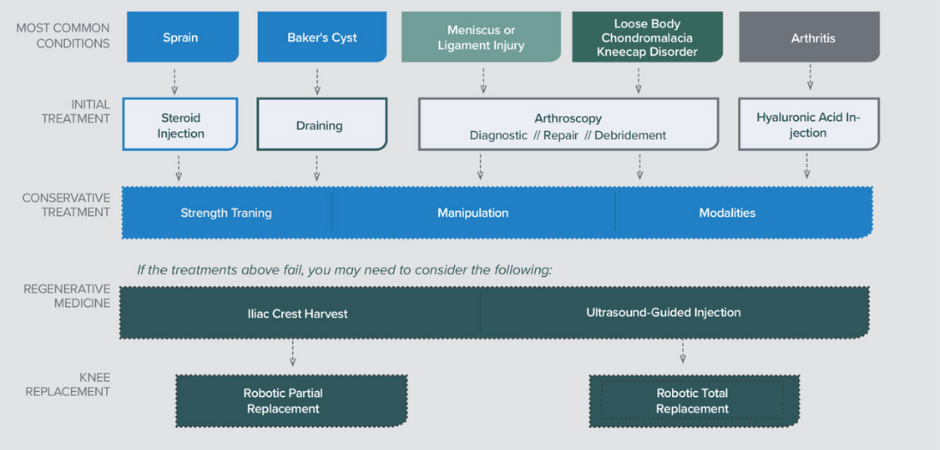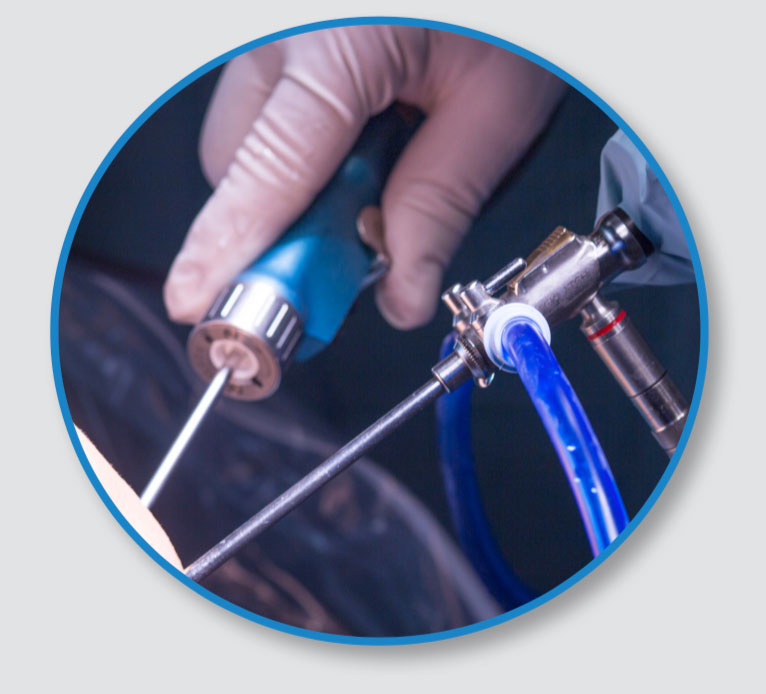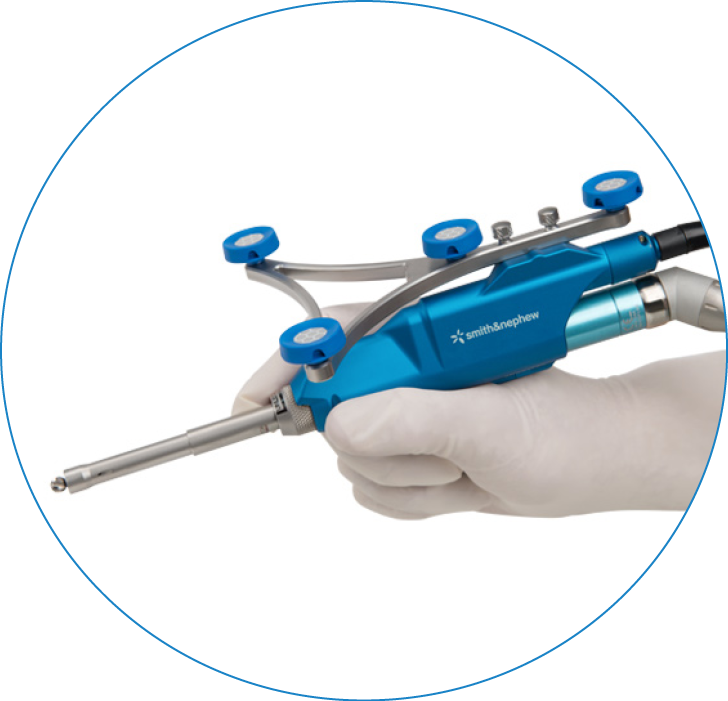WHY DOES MY KNEE HURT?
Anatomy & Conditions of the Knee

ARTHRITIS
Arthritis is the most common cause of knee pain in people over 50 and is rare in people under 30. The underlying problem is inflammation of the knee joint. Any type of arthritis can affect the knee, but the most common types are osteoarthritis, rheumatoid arthritis, and arthritis following an injury. The knee is often stiff and painful when you wake up or with bad weather, loosens up as you use it, then gets worse as the day goes on. Your knee may hurt to move, pops and clicks with use, and even buckles under your body weight if you move it wrong. The initial treatment for knee pain due to arthritis is an injection of a hyaluronic acid. There are many forms of this drug – the most common is called Synvisc. Another injection that can give long- lasting relief, some times up to a year, is stem cell derived growth factor injection. If all else fails to relieve the pain, you are a candidate for knee replacement. There are three compartments of the knee; if only one is affected you may be able to get away with a partial knee replacement. Compared to total, partial knee replacement is half the surgery, half the recovery, and people really like it. If two or more compartments are affected, then a total knee replacement is recommended.
BAKER’S CYST
These fluid-filled sacs behind the knee cause pain and tightness while bending that can get worse with activity. The hallmark of a Baker’s cyst is a sense of painful fullness in your knee. Depending on their size, you may be able to actually feel the cyst in the soft space behind your knee. You can’t see them on an x-ray, but they show up really well and are therefore diagnosed by MRI. The first approach is to drain the cyst with the help of ultrasound. If that fails, an orthopedic surgeon will take a closer look arthroscopically to see why the joint fluid is gathering before we eliminate it from your knee.
CHONDROMALACIA
When there’s an abnormality of the cartilage covering the surfaces of the knee, it can become swollen and painful due to the joint’s natural movement. The pain is the same as arthritis of the knee. Surgeons clean out and remove those shaggy, abnormal edges through an arthroscope.
WHAT CAN I DO?

Treatments for most common knee conditions
ARTHROSCOPY
Even though your knee hurts, an MRI doesn’t always show what’s wrong. In that case, an orthopedic surgeon will perform a minimally invasive procedure called arthroscopy, also known as a “scope.” During the procedure, your orthopedic surgeon places a small tube attached to a camera in your knee to find the injury. The surgeon can also remove loose bodies, clean out damaged cartilage or a torn meniscus, or drain and remove a Baker’s Cyst. The procedure takes 30 to 45 minutes, and most patients recover in a few days and are back to normal activity within a week. Complete ACL tears with instability are fixed or replaced through the arthroscope as well. The torn ACL is replaced using either a piece of your own tendon or one from a cadaver donation. After the procedure, weeks of rehabilitation are necessary to get you back in the game.

HYALURONIC ACID INJECTIONS
Arthritis is one of the most common causes of knee pain. In the early stages, it can be treated with injections of hyaluronic acid such as Synvisc. These solutions act as lubricants. It makes sense that your knee joint will hurt less if it’s better lubricated. The injection process takes just a few minutes. The skin on the side of your knee is numbed, then ultrasound is used to guide a needle to just the right place. You’ll feel some pressure in your joint during the injection, but most people don’t need sedation. You can go home afterward, and recovery is the same day.
CONSERVATIVE TREATMENT
After initial treatment, you’ll see your provider for:
- STRENGTH TRAINING (rehab) — at home exercises that can increase mobility and strength in the legs
- MANIPULATION — manual movements of the knee and leg
- MODALITIES — ice, warm packs, ultrasound, cold laser
MY KNEE STILL HURTS. WHAT'S NEXT?
Most of the time, initial treatment and conservative care are all that’s needed. If your knee still hurts, the next steps to consider are regenerative medicine or a robotic knee replacement.
REGENERATIVE MEDICINE
Remember when you were young, and things healed in days—not weeks or months? As we age, our body has fewer stem cells, making it harder to heal. Stem cell injection puts back what you’re missing. There are two types of regenerative strategies:
STEM CELL INJECTION
After age 30, most stem cells are in your bone marrow or fat. Doctors prefer to use the stem cells in the bone marrow because they are stronger and less likely to have toxins than those in fat. These stem cells are taken from the bone marrow of your pelvis through a needle. Sedation is not required, but many patients appreciate it.
AMNIOTIC-DERIVED GROWTH FACTOR INJECTION
Labs can now grow cells from the amniotic membrane which protected a baby in her mother. Needless to say, no babies were hurt to make these cells. After birth, the membrane is normally just thrown away. These labs take the membrane and grow its cells. The hundreds of growth factor proteins they make can be harvested, sterilized, and injected to help you heal. After isolation, the cells or growth factors are then injected into your knee with a needle guided by ultrasound. The injection is uncomfortable, but not typically painful enough for sedation. You are able to go home afterward, and recovery is generally less than two days. The only restriction is not to take anti-inflammatory medications for a few weeks. Keep in mind, most of the time regenerative medicine is NOT covered by insurance.

ROBOTIC-ASSISTED KNEE REPLACEMENT
In more than half of patients who need a knee replacement, only part of the knee needs to be replaced. A partial knee replacement has half the risk, half the recovery, and higher satisfaction (96%) than a total knee replacement (70%). The Smith & Nephew knee implant we use is the only implant approved by the FDA to last at least 30 years. The goal is to solve your problem in the least invasive way possible, your doctor should evaluate you for partial knee replacement before considering total knee replacement.

KNEE REPLACEMENT
When all other treatment options have failed to give you relief, you may need a robotic knee replacement. Many orthopedic surgeons use a Robotic System for the most precise placement of the best fitting implant. Some doctors don’t use the robot for knee replacement surgery, despite it being 400% more precise, and allowing advanced decision making to pick the perfect implant. We wouldn’t have surgery without the robot, so we don’t expect you to either!
SHELLY SAID GOODBYE TO KNEE PAIN
Horseback riding. Cycling, Running. Hiking. These are all activities that Shelly loved to do – but they took a toll on her knee. She fought through the pain of bone-on-bone arthritis, until she was no longer able to care for her aging father.
That’s when she decided to take action. Dr. Jimmy Chow used the NAVIO robotic system to precisely place Shelly’s knee implant. Watch her story.
WHY OUTPATIENT & ROBOTIC-ASSISTED?
Solve your knee pain problems with the least invasive treatment possible.










